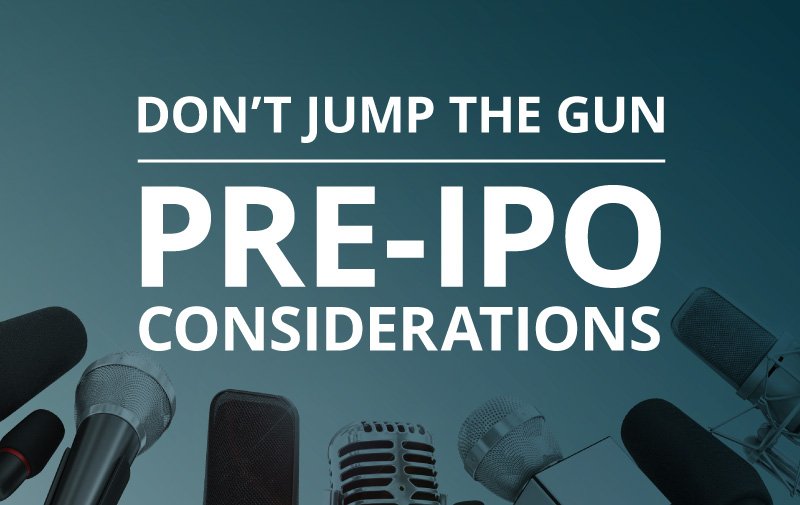With the right team in place, a compelling growth story, a comprehensive long-range plan, and a clear line of sight towards an IPO, executives become exceedingly proficient in marketing their company and its value proposition to a multitude of stakeholders. As they prepare for their organizational meeting and the official launch of the IPO process, it’s prudent for these marketing experts to brush up on so-called “gun jumping” restrictions and the implications of improper disclosure and solicitation.
“Gun-jumping” serves as a blanket term, not officially defined in the U.S. securities laws, that refers to violations of the communications restrictions under the Securities Act.
Specifically, SEC regulations prohibit communications outside of a normal course of business that improperly solicit the securities to be offered in an IPO. The restrictions are designed in part to ensure that proper risk disclosure is conveyed fairly and comprehensively to all potential investors. The specifics of these restrictions evolve through the stages of the IPO, becoming relevant as soon as the company reaches an agreement with its lead underwriter(s) and remaining in effect up to 25 days following the pricing of the IPO as underwriters continue to sell shares. While exceptions implemented as part of the JOBS Act have made gun jumping somewhat less of a concern for certain emerging growth companies who are now able to “test the waters,” companies deemed to have “jumped the gun” will see their offering delayed for weeks or months and their credibility on the Street significantly eroded.
“Gun-jumping” restrictions apply to every corporate communication, from press releases and social media posts to marketing campaigns and simple emails that could be considered intentional or unintentional solicitation. Statements made about a company’s future prospects are the most likely to be considered as improper solicitation, and, as a matter of practice, an issuer should avoid public disclosure of any financial forecasts or projections, expected valuations, and IPO proceeds; they should implement specific disclosure procedures for all public materials. With an IPO around the corner, companies and their communications partners should also consistently seek review by counsel before disseminating any written materials, and employees responsible for generating and posting written content should be educated on the nuances of “gun-jumping” restrictions. Proper review and approval policies are particularly critical for press releases, which under Securities Act Rule 169 are exempted from “gun-jumping” restrictions so long as they are considered regularly released business information in line with prior communications and exclude any forward-looking statements. Companies should also conduct comprehensive reviews of websites, social media accounts, and other existing marketing materials to ensure that content is factually correct and well aligned with the registration statement to avoid being considered an illegal offer of securities.
“Gun-Jumping” restrictions also apply to oral communications, particularly those with potential IPO investors via 1×1 meetings and media interviews. While emerging growth companies are afforded the ability to hold testing the waters (TTW) meetings in the so-called “quiet period” between the organizational meeting and the filing of the registration statement per Section 5(d) of the Securities Act, management teams should be extremely careful to avoid making an offer as defined by the SEC. Specifically, they should avoid making an explicit case for purchasing shares of the company, making any forward looking statements, or discussing specifics around expectations for the IPO.
Once the registration statement is filed publicly but not yet declared effective, emerging growth companies are afforded the ability to make oral and certain written offers on TTW and official IPO roadshow meetings. These conversations may reference a preliminary prospectus, or “red herring,” which can be used to make written offers and include a price range for the offering. They cannot reference a final offering price or corresponding proceeds and underwriting discounts. For the IPO roadshow, slide decks, handouts, and videos presented during the time of the meeting are not considered to be written offers so long as copies are not left behind. By collecting these materials, companies avoid having them considered free writing prospectuses (FWP), which are otherwise used after the registration statement is filed but before it becomes effective to inform potential investors of any changes to the offering. Companies are also able to publish a limited notice of the upcoming IPO in addition to disseminating a rather boilerplate press release upon pricing.
Once the IPO has priced, company communications remain somewhat restricted as underwriters continue to sell shares before their final prospectus is delivered within 25 calendar days. During this time, management must not disclose information or make forward-looking or speculative statements that would make the prospectus inaccurate.
In all, executives should pay special attention to “gun-jumping” restrictions throughout the entire IPO process and remain closely aligned with their IR team and legal counsel. This will help them avoid running afoul of these somewhat nuanced regulations that can derail an IPO and lead to less than favorable media attention. If you’re considering an IPO or would like more information on “gun-jumping,” contact our team today.
Brian Johnston, Vice President


Leave a Reply